Data Handling and Presentation NCERT Solutions | Mathematics for Class 6 PDF Download
| Table of contents |

|
| Page 75 |

|
| Page 76 |

|
| Page 77 |

|
| Page 78 |

|
| Page 83 & 84 |

|
| Page 86 |

|
| Page 88 |

|
| Page 93 & 94 |

|
| Page 95 |

|
| Page 96 |

|
| Page 97 |

|
| Page 98 |

|
| Page 99 & 100 |

|
| Page 103 |

|
Page 75
Naresh and Navya decided to go to each student in the class and ask what their favourite game is. Then they prepared a list.
Navya is showing the list: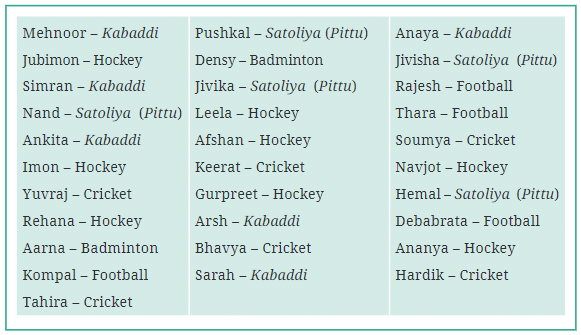 She says (happily), "l have collected the data. I can figure out the most popular game now!"
She says (happily), "l have collected the data. I can figure out the most popular game now!"
A few other children are looking at the list and wondering, "We can't yet see the most popular game. How can we get it from this list?"
Ans: Based on the data, here is how the favourite games of the students are distributed:
- Kabaddi: 6 students (Mehnoor, Simran, Ankita, Anaya, Arsh, Sarah)
- Hockey: 8 students (Jubimon, Leela, Afshan, Imon, Rehana, Gurpreet, Navjot, Ananya)
- Satoliya (Pittu): 5 students (Nand, Pushkal, Jivika, Jivisha, Hemal)
- Cricket: 6 students (Yuvraj, Keerat, Soumya, Bhavya, Tahira, Hardik)
- Football: 4 students (Rajesh, Thara, Kompal, Debabrata)
- Badminton: 2 students (Densy, Aarna)

Most Popular Game: Hockey is the most popular game, with 8 students choosing it.
Figure it Out
Q1: What would you do to find the most popular game among Naresh’s and Navya’s classmates?
Ans: To find the most popular game, we need to organize the given data and interpret the results by using tally marks, pictographs and bar graphs.
Q2: What is the most popular game in their class?
Ans: The most popular game in their class is Hockey, as it has the highest number of students who prefer it (7 students).
Q3: Try to find out the most popular game among your classmates.
Ans: Cricket is the most popular game among our classmates.
Q4: Pari wants to respond to the questions given below. Put a tick (✔) for the questions where she needs to carry out data collection and put a cross (✘) for the questions where she doesn’t need to collect data. Discuss your answers in the classroom.
(a) What is the most popular TV show among her classmates?
Ans: ✔ (Data collection is needed to find out the most popular TV show.)
(b) When did India get independence?
Ans: ✘ (This is a fact that does not require data collection.)
(c) How much water is getting wasted in her locality?
Ans: ✔ (Data collection is needed to measure the amount of water wasted.)
(d) What is the capital of India?
Ans: ✘ (This is a known fact that does not require data collection.)
Page 76
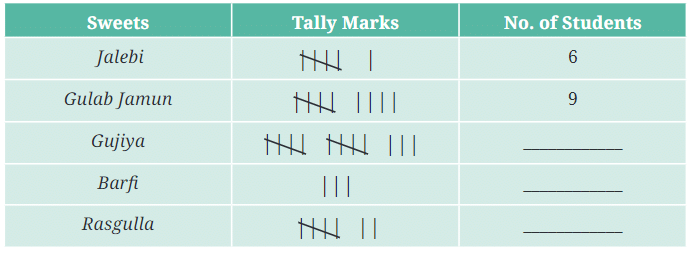
Figure it Out
Q1: Complete the table to help Shri Nilesh to purchase the correct numbers of sweets:
- How many students chose jalebi? _______
Ans: 6 students chose jalebi. - Barfi was chosen by_______ students?
Ans: Barfi was chosen by 3 students. - How many students chose gujiya?_______
Ans: Gujiya was chosen by 13 students. - Rasgulla was chosen by _______ students?
Ans: Rasgulla was chosen by 7 students. - How many students chose gulab jamun?_______
Ans: Gulab jamun was chosen by 9 students.
Shri Nilesh requested one of the staff members to bring the sweets as given in the table. The above table helped him to purchase the correct number of sweets.
Q2: Is the above table sufficient to distribute each type of sweet to the correct student? Explain. If it is not sufficient, what is the alternative?
Ans: No, this table is not sufficient to distribute each type of sweet to the given student because it only gives us information about the number of students liking a particular sweet and nothing else.
But, in order to distribute each type of sweet to the correct student, we need raw data that links each student to the specific sweet they like.
Page 77
 She then arranged the shoe sizes of the students in ascending order—
She then arranged the shoe sizes of the students in ascending order—
Figure it Out
Q1: Help her to figure out the following –
- The largest shoe size in the class is _________.
Ans: The largest shoe size in the class is 7. - The smallest shoe size in the class is _________.
Ans: The smallest shoe size in the class is 3. - There are _________ students who wear shoe size 5.
Ans: There are 10 students who wear shoe size 5. - There are _________ students who wear shoe sizes larger than 4.
Ans: There are 15 students who wear shoe sizes larger than 4.
Q2: How did arranging the data in ascending order help to answer these questions?
Ans: Arranging the data in ascending order made it easier to identify the smallest and largest shoe sizes and to count how many students wear each size.
Q3: Are there other ways to arrange the data?
Ans: Yes, the data can also be arranged in descending order, where the largest sizes come first, or it can be categorised based on the frequency of each shoe size.
Page 78
Q4: Write the names of a few trees you see around you. When you observe a tree on the way from your home to school (or while walking from one place to another place), record the data and fill in the following table —
(a) Which tree was found in the greatest number?
(b) Which tree was found in the smallest number?
(c) Were there any two trees found in the same numbers?
Ans: 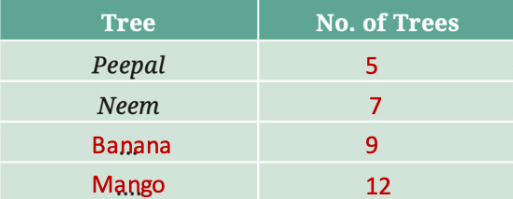 (a) Mango tree.
(a) Mango tree.
(b) Peepal tree.
(c) No, there were no two trees found in the same number.
Q5: Take a blank piece of paper and paste any small news item from a newspaper. Each student may use a different article. Now, prepare a table on the piece of paper as given below. Count the number of each of the letters ‘c’, ‘e’, ‘i’, ‘r’, and ‘x’ in the words of the news article, and fill in the table.
(a) The letter found the most number of times is ________.
(b) The letter found the least number of times is ________.
(c) List the five letters ‘c’, ‘e’, ‘i’, ‘r’, ‘x’ in ascending order of frequency. Now, compare the order of your list with that of your classmates. Is your order the same or nearly the same as theirs? (Almost everyone is likely to get the order ‘x, c, r, i, e’.) Why do you think this is the case?
(d) Write the process you followed to complete this task.
(e) Discuss with your friends the processes they followed.
(f) If you do this task with another news item, what process would you follow?
Ans: 
(a) The letter is 'a'.
(b) The letter is 'x'.
(c) Letters in ascending order : x, c, r, i, e.
Yes, my order is nearly the same as theirs. Almost everyone is likely to get the same order because it reflects the standard frequency of usage of these letters in the English language.
(d) I made tally marks for the given letters to complete the task.
(e) To be done by the students.
(f) I would again use tally marks.
Page 83 & 84
Figure it Out
Q1: The following pictograph shows the number of books borrowed by students, in a week, from the library of Middle School, Ginnori: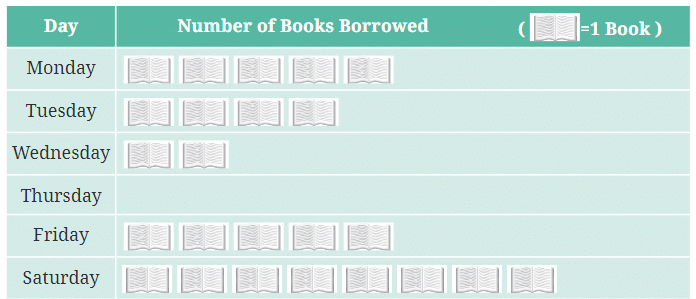
(a) On which day were the minimum number of books borrowed?
Ans: Thursday
(b) What was the total number of books borrowed during the week?
Ans: Total number of books borrowed = 5 + 4 + 2 + 0 + 5 + 8 = 24 books.
(c) On which day were the maximum number of books borrowed? What may be the possible reason?
Ans: The maximum number of books was borrowed on Saturday. Sunday being a day off, c. students might see it as an opportunity to spend time reading books.
Q2: Magan Bhai sells kites at Jamnagar. Six shopkeepers from nearby villages come to purchase kites from him. The number of kites he sold to these six shopkeepers are given below: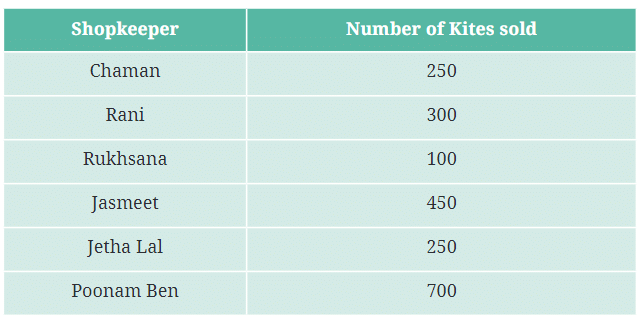
Prepare a pictograph using the symbol  to represent 100 kites. Answer the following questions:
to represent 100 kites. Answer the following questions:
(a) How many symbols represent the kites that Rani purchased?
(b) Who purchased the maximum number of kites?
(c) Who purchased more kites, Jasmeet or Chaman?
(d) Rukhsana says Poonam Ben purchased more than double the number of kites that Rani purchased. Is she correct? Why?
Ans:
 (a) 3 symbols represent the kites that Rani purchased.
(a) 3 symbols represent the kites that Rani purchased.
(b) Poonam Ben.
(c) Jasmeet purchased more kites than Chaman.
(d) Yes, she is correct because 700 kites is more than double 300 kites.
Double of 300 kites = 2 x 300 kites = 600 kites.
Therefore, 700 kites is indeed more than 600 kites.
Page 86
Answer the following questions using the bar graph:
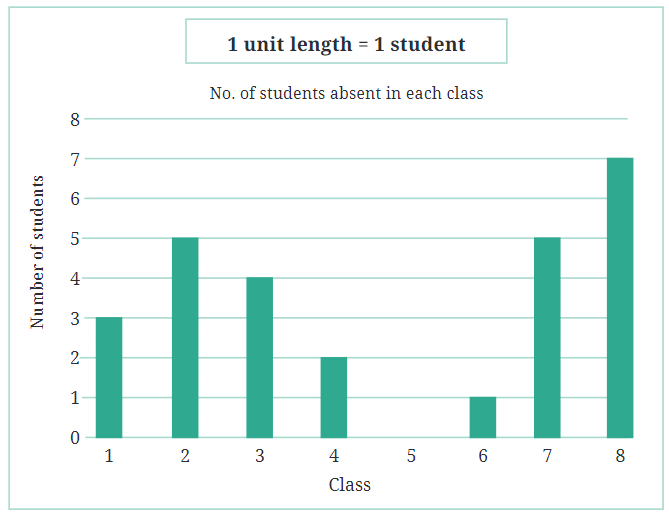 Q1: In Class 2, ___________ students were absent that day.
Q1: In Class 2, ___________ students were absent that day.
Ans: In Class 2, 5 students were absent that day.
Q2: In which class were the maximum number of students absent? ___________
Ans: The maximum number of students was absent in Class 8. ( Absent Students =7)
Q3: Which class had full attendance that day? ___________
Ans: Class 5 had full attendance that day.
Page 88
Figure it Out
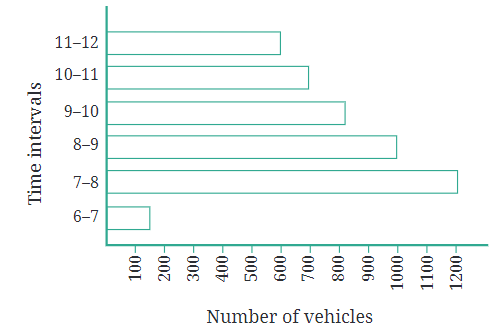 Q1: How many total cars passed through the crossing between 6 am and noon?
Q1: How many total cars passed through the crossing between 6 am and noon?
Ans: Total cars = 150 + 1200 + 1000 + 800 + 700 + 600 = 4450 cars.
Q2: Why do you think so little traffic occurred during the hour of 6–7 am, as compared to the other hours from 7 am to noon?
Ans: Most people start their day a bit later than 6 am. Many businesses, schools, and offices open after 8 or 9 am, resulting in less traffic during the hour of 6-7 am.
Q3: Why do you think the traffic was the heaviest between 7 am and 8 am?
Ans: The traffic was the heaviest between 7 am and 8 am because many people were commuting to work or school around this time.
Q4: Why do you think the traffic was lesser and lesser each hour after 8 am all the way until noon?
Ans: The traffic was lesser and lesser each hour after 8 am all the way until noon because most commuters have reached their destination by 8 am.
Page 93 & 94
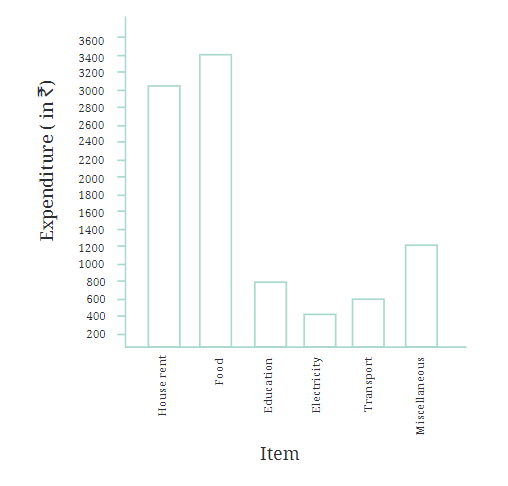 Use the bar graph to answer the following questions:
Use the bar graph to answer the following questions:
Q1: On which item does Imran's family spend the most and the second most?
Ans: Imran's family spends the most on food. The second most is spent on house rent.
Q2: Is the cost of electricity about one-half the cost of education?
Ans: Yes, the cost of electricity (₹400) is about half the cost of education (₹800), as ₹400 is exactly 50% of ₹800.
Q3: Is the cost of education less than one-fourth the cost of food?
Ans: No, the cost of education (₹800) is not less than one-fourth the cost of food (₹3400). One-fourth of ₹3400 is ₹850, and the cost of education is only slightly less than this, but not less than one-fourth.
Figure it Out
Q1: Samantha visited a tea garden and collected data of the insects and critters she saw there. Here is the data she collected:
Help her prepare a bar graph representing this data.
Ans: 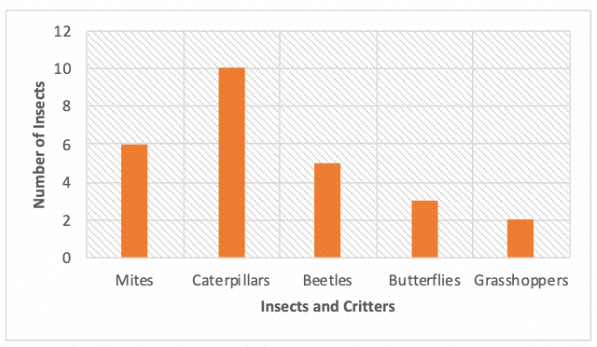
Q2: Pooja collected data on the number of tickets sold at the Bhopal railway station for a few different cities of Madhya Pradesh over a 2-hour period.
She used this data and prepared a bar graph on the board to discuss the data with her students, but someone erased a portion of the graph.
(a) Write the number of tickets sold for Vidisha above the bar.
Ans: The number of tickets sold for Vidisha is 24.
(b) Write the number of tickets sold for Jabalpur above the bar.
Ans: The number of tickets sold for Jabalpur is 20.
(c) The bar for Vidisha is 6 unit lengths and the bar for Jabalpur is 5 unit lengths. What is the scale for this graph?
Ans: For Vidisha,
6 unit bar length = 24 tickets
1 unit bar length = 24/6
1 unit bar length = 4 tickets.
For Jabalpur,
5 unit bar length = 20 tickets
1 unit bar length = 20/5
1 unit bar length = 4 tickets.
Therefore, Scale for this graph: 1 unit length = 4 tickets
(d) Draw the correct bar for Sagar.
Ans: 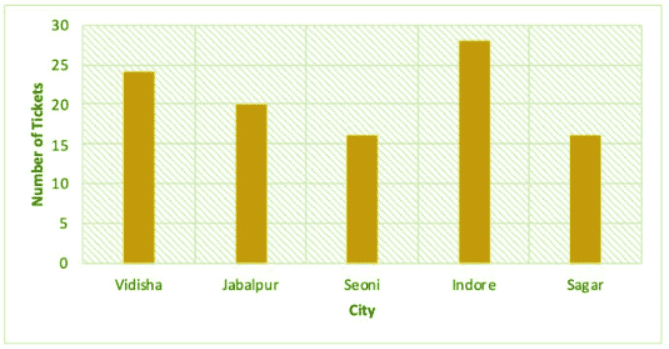
(e) Add the scale of the bar graph, placing the correct numbers on the vertical axis.
Ans: The scale of the bar graph, placing the correct numbers on the vertical axis, is shown in the above graph.
(f) Are the bars for Seoni and Indore correct in this graph? If not, draw the correct bar(s).
Ans: No, the bars for Seoni and Indore are not correct in the given graph. The correct bars for Seoni and Indore are given in the above graph.
Q3: Chinu listed the various means of transport that passed across the road in front of his house from 9 AM to 10 AM:
(a) Prepare a frequency distribution table for the data.
Ans: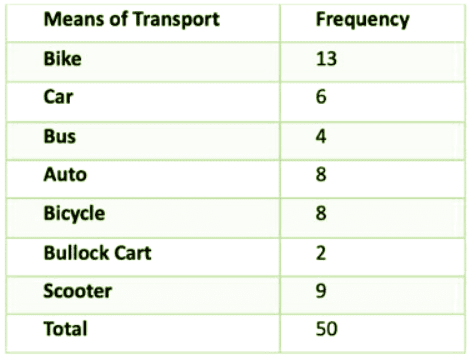
(b) Which means of transport was used the most?
Ans: The Bike was used the most.
(c) If you were there to collect this data, how could you do it? Write the steps or process.
Ans: If I were there to collect the data, I would follow the given steps:
(i) Create a table on paper with columns.
(ii) Write the means of transport in one column and include a column for tally marks.
(iii) As a vehicles pass, record each one in the appropriate category.
(iv) Use tally marks for a quick count and then add them at the end of the observation period for each type of transport.
Page 95
Q4: Roll a die 30 times and record the number you obtain each time. Prepare a frequency distribution table using tally marks. Find the number that appeared:
(a) The minimum number of times.
(b) The maximum number of times.
(c) Find numbers that appeared an equal number of times.
Ans: Let the outcomes of 30 times roll of a die be
6, 2, 3, 5, 6, 4, 1, 1, 2, 5
3, 4, 1, 1, 3, 5, 2, 2, 1, 1
6, 2, 3, 5, 1, 2, 2, 3, 4, 2
(a) 4 and 6
(b) 2
(c) 4 and 6
Q5: Faiz prepared a frequency distribution table of data on the number of wickets taken by Jaspreet Bumrah in his last 30 matches:
(a) What information is this table giving?
Ans: The information in the table gives an overview of the number of matches in which he took wickets from 0 to 7.
(b) What may be the title of this table?
Ans: Frequency distribution table indicating the bowling performance of Jaspreet Bumrah.
(c) What caught your attention in this table?
Ans: Bumrah has taken 3 or more wickets in most of the matches
(d) In how many matches has Bumrah taken 4 wickets?
Ans: 3 matches.
(e) Mayank says “If we want to know the total number of wickets he has taken in his last 30 matches, we have to add the numbers 0, 1, 2, 3 …, up to 7.” Can Mayank get the total number of wickets taken in this way? Why?
Ans: No because it can be done only by multiplying the wickets taken by the number of matches.
(f) How would you correctly figure out the total number of wickets taken by Bumrah in his last 30 matches, using this table?
Ans: Total wickets taken by Bumrah = 1 x 4 + 2 x 6 + 3 x 8 + 4 x 3 + 5 x 5 + 6 x 1 + 7 x 1 in last 30 matches = 4 + 12 + 24 + 12 + 25 + 6 + 7 = 90.
Page 96
Q6: The following pictograph shows the number of tractors in five different villages.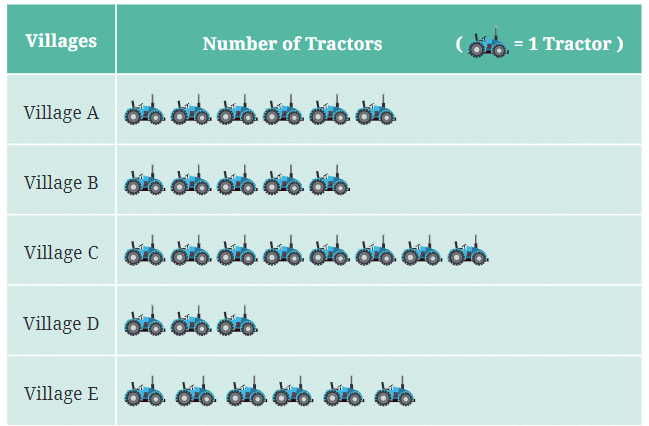 Observe the pictograph and answer the following questions—
Observe the pictograph and answer the following questions—
(a) Which village has the smallest number of tractors?
Ans: Village D has the smallest number of tractors.
(b) Which village has the most tractors?
Ans: Village C has the most tractors.
(c) How many more tractors does Village C have than Village B?
Ans: 3 more tractors than B
(d) Komal says, “Village D has half the number of tractors as Village E.” Is she right?
Ans: Tractors in Village D = 3
Tractors in Village E = 6
Yes, Komal is right in saying that Village D has half the number of tractors than Village E.
Page 97
Q7: The number of girl students in each class of a school is depicted by a pictograph: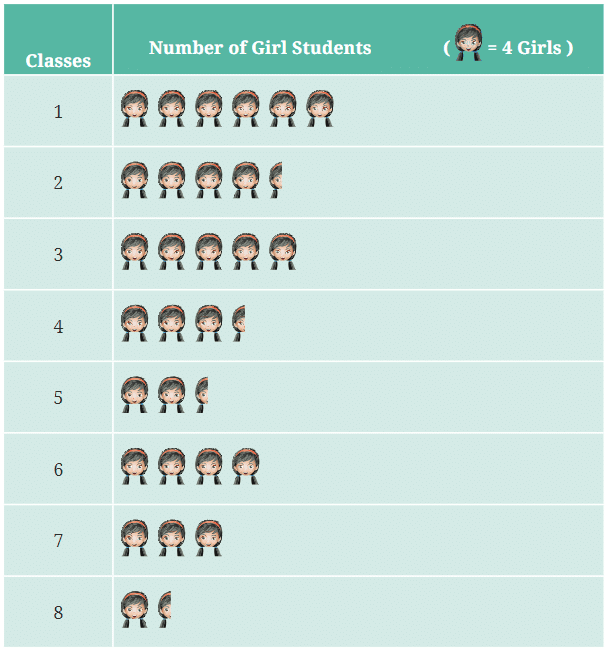
(a) Which class has the least number of girl students?
Ans: Class 8 has the least number of girl students.
(b) What is the difference between the number of girls in Class 5 and 6?
Ans: Number of Girls in class 6 = 4 × 4 = 16
Number of Girls in class 5 = 4 × 2.5 = 10
Hence difference = 16 – 10 = 6
(c) If 2 more girls were admitted in Class 2, how would the graph change?
Ans: The graph will have 5 full symbols of girls.
(d) How many girls are there in Class 7?
Ans: Girls in Class 7 = 3 x 4 = 12.
Page 98
Q8: Mudhol Hounds (a type of breed of Indian dogs) are largely found in North Karnataka’s Bagalkote and Vijaypura districts. The government took an initiative to protect this breed by providing support to those who adopted these dogs. Due to this initiative, the number of these dogs increased. The number of Mudhol dogs in six villages of Karnataka are as follows:
Village A : 18, Village B : 36, Village C : 12, Village D : 48, Village E : 18, Village F : 24
Prepare a pictograph and answer the following questions: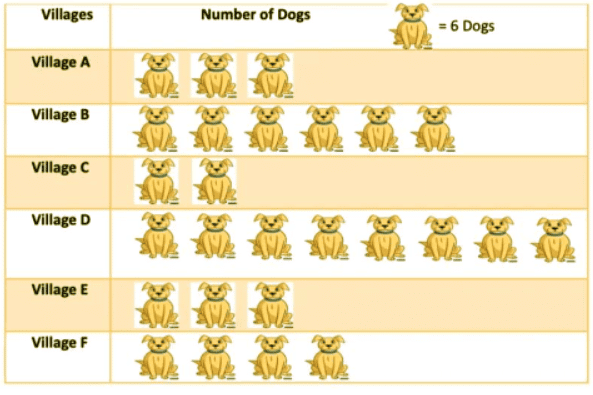
(a) What will be a useful scale or key to draw this pictograph?
Ans: Scale: One symbol represents 6 dogs.
(b) How many symbols will you use to represent the dogs in Village B?
Ans: 6 symbols will be used to represent the dogs in Village B.
(c) Kamini said that the number of dogs in Village B and Village D together will be more than the number of dogs in the other 4 villages. Is she right? Give reasons for your response.
Ans: Yes, Kamini is correct. The combined total of dogs in Village B and Village D is 84 (36 + 48). The total for the other four villages is 72 (18 + 12 + 18 + 24). Therefore, 84 is greater than 72, so Kamini is right.
Q9: A survey of 120 school students was conducted to find out which activity they preferred to do in their free time.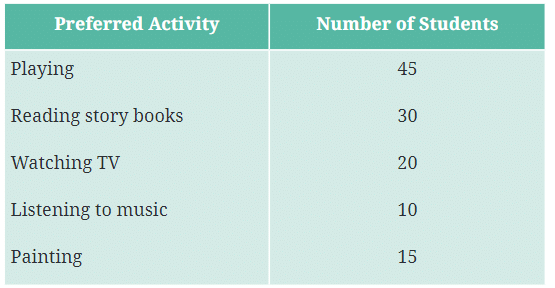
Draw a bar graph to illustrate the above data taking the scale of 1 unit length = 5 students. Which activity is preferred by most students other than playing?
Ans: 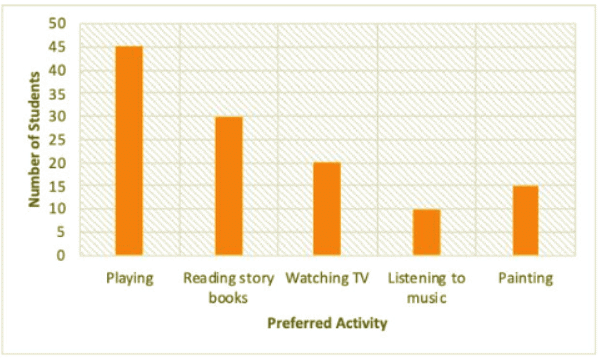 Most students prefer reading story books other than playing.
Most students prefer reading story books other than playing.
Page 99 & 100
Q10: Students and teachers of a primary school decided to plant tree saplings in the school campus and in the surrounding village during the first week of July. Details of the saplings they planted are as follows:
(a) The total number of saplings planted on Wednesday and Thursday is ___________.
Ans: Total saplings planted on Wednesday and Thursday = 30 + 40 = 70 saplings.
(b) The total number of saplings planted during the whole week is ___________.
Ans: Total saplings planted during the whole week = 52 + 40 + 30 + 40 + 50 + 60 + 40 = 312 saplings.
(c) The greatest number of saplings were planted on ___________, and the least number of saplings were planted on ___________.
Ans: The greatest number of saplings were planted on Saturday, and the least number of saplings were planted on Wednesday.
At the beginning of the week (Monday), People might have higher energy levels, resulting in more saplings being planted.
But as the week progresses, people may get fatigued due to work or other activities, resulting in fewer plantation of saplings.
By Friday and Saturday, people might be more willing to go outdoors and engage in activities like plantation.
The decline in the plantation of saplings on Sunday might be due to exhaustion after the weekend.
Q11: The number of tigers in India went down drastically between 1900 and 1970. Project Tiger was launched in 1973 to track and protect tigers in India. Starting in 2006, the exact number of tigers in India was tracked. Shagufta and Divya looked up information about the number of tigers in India between 2006 and 2022 in 4-year intervals. They prepared a frequency table for this data and a bar graph to present this data, but there are a few mistakes in the graph. Can you find those mistakes and fix them?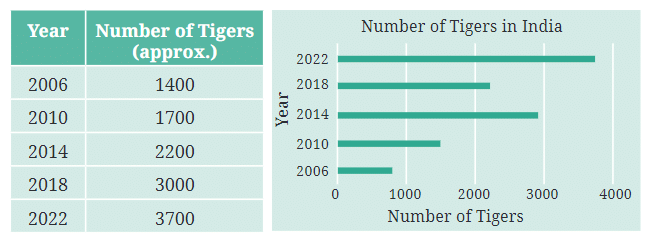
Ans: Yes, there are a few mistakes in the graph.
And a correct bar graph would be this:
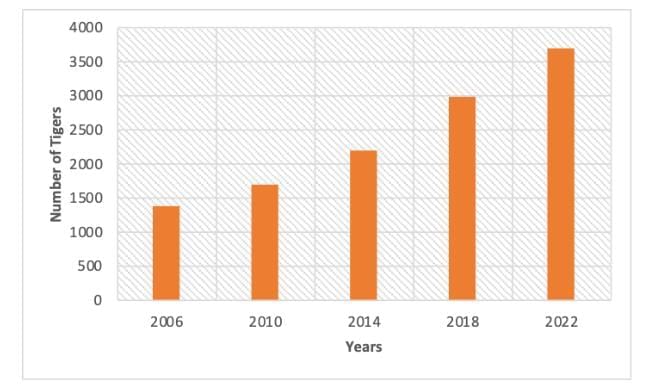
- No. of tigers in 2006 was 1400 but shown less in the graph.
- No. of tigers in 2014 was 2200 but shown more in the graph.
- No. of tigers in 2018 was 3000 but shown less in the graph.
Page 103
Figure it Out
Q1: If you wanted to visually represent the data of the heights of the tallest persons in each class in your school, would you use a graph with vertical bars or horizontal bars? Why?
Ans: I would use vertical bars because it is more intuitive, suggestive, and visually appealing to represent heights, that are measured upwards from the ground, using bar graphs that have vertical bars or columns.
Q2: If you were making a table of the longest rivers on each continent and their lengths, would you prefer to use a bar graph with vertical bars or with horizontal bars? Why? Try finding out this information, and then make the corresponding table and bar graph! Which continents have the longest rivers?
Ans: I would prefer to use horizontal bars because lengths that are parallel to the ground (e.g., distances between location on Earth) are usually best represented using bar graphs with horizontal bars.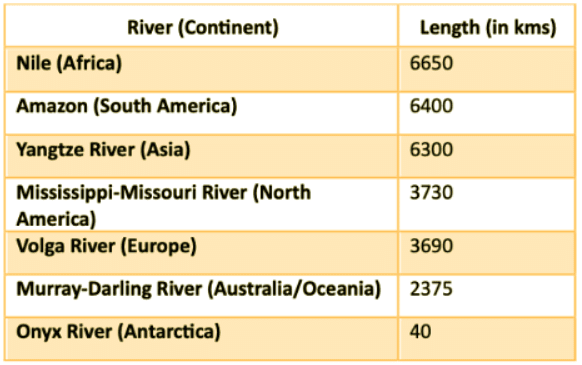

|
48 videos|334 docs|23 tests
|
FAQs on Data Handling and Presentation NCERT Solutions - Mathematics for Class 6
| 1. What is data handling and why is it important in daily life? |  |
| 2. What are the different types of data representation used in Class 6? |  |
| 3. How can we interpret a bar graph? |  |
| 4. What are the steps involved in collecting data for a survey? |  |
| 5. How do we find the mean, median, and mode of a data set? |  |





















